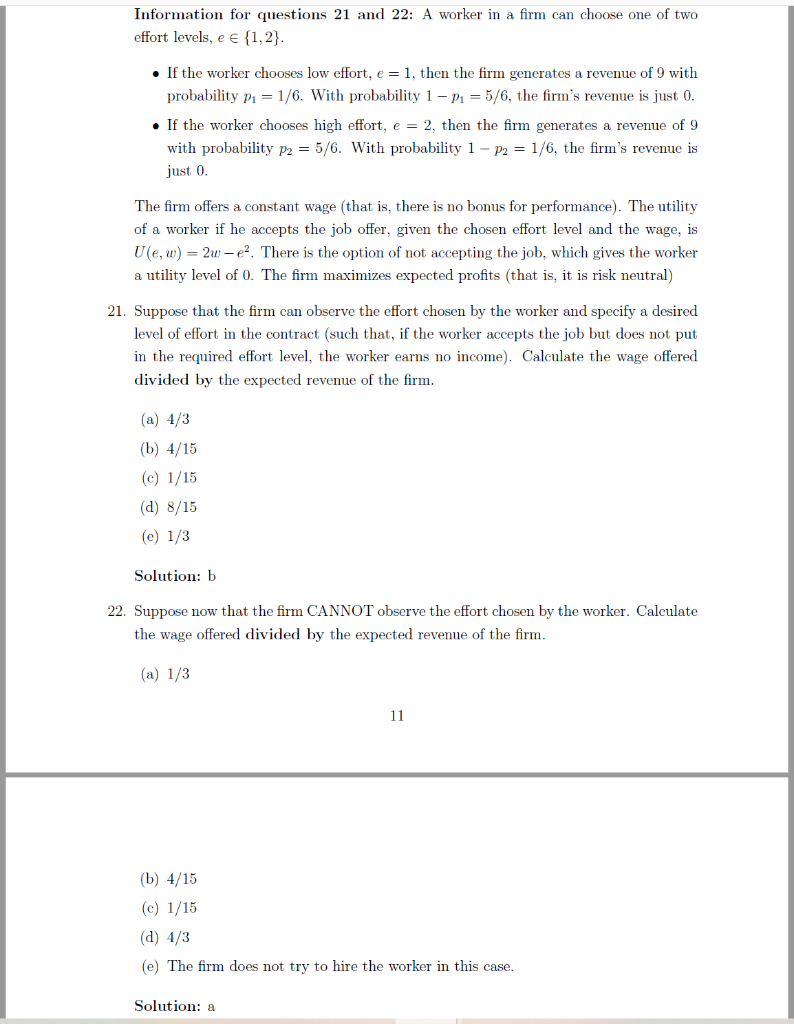Information for questions 21 and 22: A worker in a firm can choose one of two effort levels, e € {1, 2}. • If the worker chooses low effort, e = 1, then the firm generates a revenue of 9 with probability pi = 1/6. With probability 1 – P = 5/6, the firm's revenue is just 0. • If the worker chooses high effort, e = 2, then the firm generates a revenue of 9 with probability p2 = 5/6. With probability 1 – p2 = 1/6, the firm's revenue is just 0. The firm offers a constant wage (that is, there is no bonus for performance). The utility of worker if be accents the joh offer given the chosen offort lovel end the wege is
Information for questions 21 and 22: A worker in a firm can choose one of two effort levels, e € {1, 2}. • If the worker chooses low effort, e = 1, then the firm generates a revenue of 9 with probability pi = 1/6. With probability 1 – P = 5/6, the firm's revenue is just 0. • If the worker chooses high effort, e = 2, then the firm generates a revenue of 9 with probability p2 = 5/6. With probability 1 – p2 = 1/6, the firm's revenue is just 0. The firm offers a constant wage (that is, there is no bonus for performance). The utility of worker if be accents the joh offer given the chosen offort lovel end the wege is
Chapter1: Making Economics Decisions
Section: Chapter Questions
Problem 1QTC
Related questions
Question
.

Transcribed Image Text:Information for questions 21 and 22: A worker in a firm can choose one of two
effort levels, e E {1,2}.
• If the worker chooses low effort, e = 1, then the firm generates a revenue of 9 with
probability p1 = 1/6. With probability 1– P1 = 5/6, the firm's revenue is just 0.
• If the worker chooses high effort, e = 2, then the firm generates a revenue of 9
with probability p2 = 5/6. With probability 1 – P2 = 1/6, the firm's revenue is
just 0.
The firm offers a constant wage (that is, there is no bonus for performance). The utility
of a worker if he accepts the job offer, given the chosen effort level and the wage, is
U(e, w) = 2w – e?. There is the option of not accepting the job, which gives the worker
a utility level of 0. The firm maximizes expected profits (that is, it is risk neutral)
21. Suppose that the firm can observe the effort chosen by the worker and specify a desired
level of effort in the contract (such that, if the worker accepts the job but does not put
in the required effort level, the worker earns no income). Calculate the wage offered
divided by the expected revenue of the firm.
(a) 4/3
(b) 4/15
(c) 1/15
(d) 8/15
(e) 1/3
Solution: b
22. Suppose now that the firm CANNOT observe the effort chosen by the worker. Calculate
the wage offered divided by the expected revenue of the firm.
(a) 1/3
11
(b) 4/15
(c) 1/15
(d) 4/3
(e) The firm does not try to hire the worker in this case.
Solution: a
Expert Solution
This question has been solved!
Explore an expertly crafted, step-by-step solution for a thorough understanding of key concepts.
Step by step
Solved in 2 steps

Knowledge Booster
Learn more about
Need a deep-dive on the concept behind this application? Look no further. Learn more about this topic, economics and related others by exploring similar questions and additional content below.Recommended textbooks for you


Principles of Economics (12th Edition)
Economics
ISBN:
9780134078779
Author:
Karl E. Case, Ray C. Fair, Sharon E. Oster
Publisher:
PEARSON

Engineering Economy (17th Edition)
Economics
ISBN:
9780134870069
Author:
William G. Sullivan, Elin M. Wicks, C. Patrick Koelling
Publisher:
PEARSON


Principles of Economics (12th Edition)
Economics
ISBN:
9780134078779
Author:
Karl E. Case, Ray C. Fair, Sharon E. Oster
Publisher:
PEARSON

Engineering Economy (17th Edition)
Economics
ISBN:
9780134870069
Author:
William G. Sullivan, Elin M. Wicks, C. Patrick Koelling
Publisher:
PEARSON

Principles of Economics (MindTap Course List)
Economics
ISBN:
9781305585126
Author:
N. Gregory Mankiw
Publisher:
Cengage Learning

Managerial Economics: A Problem Solving Approach
Economics
ISBN:
9781337106665
Author:
Luke M. Froeb, Brian T. McCann, Michael R. Ward, Mike Shor
Publisher:
Cengage Learning

Managerial Economics & Business Strategy (Mcgraw-…
Economics
ISBN:
9781259290619
Author:
Michael Baye, Jeff Prince
Publisher:
McGraw-Hill Education